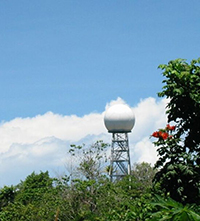A Decade and Counting
Submitter:
Long, Chuck N. — NOAA- Earth System Research Laboratory
Area of research:
Radiation Processes
Journal Reference:
Science
After more than a decade of site measurements, the U.S. Department of Energy (DOE) has amassed extensive atmospheric data collections from two tropical western Pacific sites. A team of scientists led by researchers at Pacific Northwest National Laboratory showed how these data are used extensively in atmospheric and climate research by scientists around the world. They found that observation-based research has significantly advanced our understanding of this important climate system as well as tropical clouds and air circulation in general. With the addition of new instrumentation, they show that additional data promise to provide expanded opportunities for tropical atmospheric science for years to come.
Impact
To accurately evaluate tropical clouds and atmospheric systems in climate models, DOE has established stations in several locations to take measurements of clouds, the environment in which they reside, and their impact on the sunlight and terrestrial energy and water budgets for the climate. Two DOE-sponsored sites in tropical locations are the Atmospheric Radiation Measurement (ARM) Climate Research Facility measurement site set up on Manus Island, Papua New Guinea in 1996; and the site on the island republic of Nauru, established in late 1998.
In this study, the research team presented a diverse range of samples of the scientific contributions that rely on a decade-long record from the Nauru and Manus sites. Through the ARM Publications database, they identified 143 research papers published in peer-reviewed journals, and more than 250 scientific conference proceedings that used data from Manus and Nauru. These covered research topics from large-scale tropical dynamics and variability, to cloud-scale processes and precipitation, to microphysics and aerosols. While many of these topics were part of the original ARM science vision for the Tropical Western Pacific (TWP) site, this study shows how the breadth of the research substantially exceeded expectations.
A recently expanded spatial view integrated through time will facilitate a new generation of process-oriented data analysis and modeling studies of cloud field evolution. While the existing decade-long record of clouds, radiation, and atmospheric state provides a unique observational record that will continue to be exploited by the research community, the next decade offers significant new opportunities for atmospheric research in this challenging region thanks to ongoing observations and the new improved instrumentation.
Summary
The warmest sea surface temperatures on Earth are in the TWP. This environment leads to abundant convection, which is clouds and precipitation caused by rising moist air, sometimes all the way to the top of our atmosphere. This plentiful deep convection—think of tall clouds—is one of the major forces in global atmospheric circulation and climate variability. It has a profound impact on global climate and precipitation. These equatorial TWP sites provide climate researchers with unique sets of data, now available for more than a decade of observations. With sophisticated, long-term site measurements like these, scientists can more accurately depict past and predict future climate changes.


